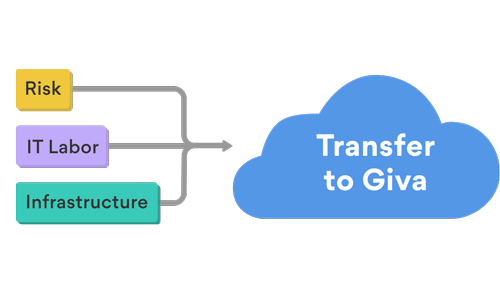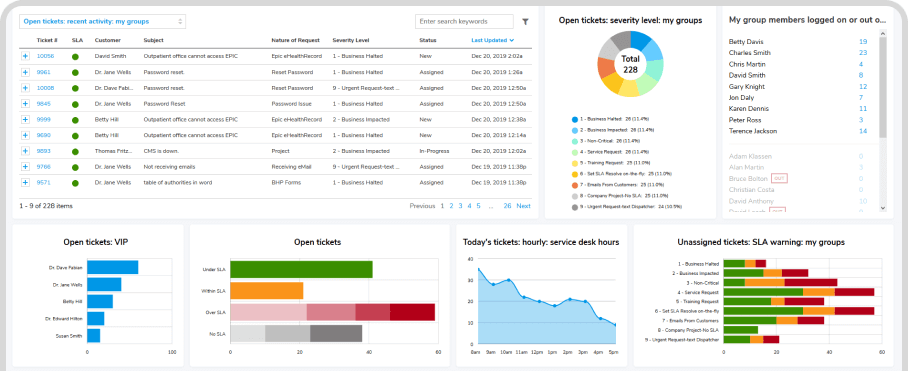Giva HIPAA-Compliant Cloud Help Desk Software
Giving You the Highest Security & Compliance of Protected Health Information (PHI), Including Electronic Health & Medical Records (EHR/EMR)
Why HIPAA-Compliant Giva?
Provide Your Customers with the Safety and Security of Giva HIPAA/HITECH Compliance
Included in All Editions at No Additional Cost & Covered by Cyber Liability Insurance Policy
- Eliminate compliance-related costs through Giva's comprehensive security-first approach, including regular vulnerability assessments and multi-level encryption
- Enhance customer trust and loyalty by demonstrating your commitment to protecting their sensitive information with the highest security and compliance measures
- Streamline your regulatory compliance processes with our annual SSAE 18 SOC 2 Type 2 compliance report
- Decrease unauthorized access attempts using our robust Multi-factor Authentication (MFA) system, safeguarding your data from evolving cyber threats
- Future-proof your security infrastructure with continuous updates that adapt to new regulations and emerging threats, ensuring long-term compliance and data protection
Business Associates Agreements (BAA): Partnering with You for a Relationship of Security
All of Giva's HIPAA-Compliant solutions include a Business Associates Agreement (BAA) to insure compliance with federal and state regulatory agencies

- A HIPAA BAA is a contract between a HIPAA-covered entity (you our customer) and a HIPAA business associate (Giva). The contract protects personal health information (PHI) in any electronic health or medical record of the covered entity.
- The signed BAA contractually obligates Giva to protect your PHI. Giva shares liability with our customers in the very unlikely event of a data breach.
- A BAA clearly defines the roles and responsibilities of Giva in protecting PHI.
- Using any cloud software without a BAA does not meet HIPAA compliance and is subject to financial penalties.
Web Browsing Remains Private with the Highest SSL Encryption
- NIST's HIPAA encryption standards recommend 128-, 192-, or 256-bit encryption. Giva uses 256-bit Secure Sockets Layer (SSL) certificates for any domains where sensitive information is accessed or displayed.
- With our high availability data center infrastructure, SSL is also installed on the load balancers to ensure end-to-end privacy.
Virtual Private Networks (VPNs) Encrypt All Data Traffic
- All remote access, system administration connections and data transfers to and from Giva's HIPAA-compliant apps are encrypted using an SSL VPN (virtual private network) with Multi Factor Authentication (MFA).
All Data is Always Encrypted
- In Motion — All sensitive electronic health and medical records data with patient health information, such as SSNs, patient diagnoses, medical histories, are encrypted using 256-bit secure sockets layer (SSL).
- Backups — Giva encrypts all backups and has HIPAA-compliant security controls in place to limit and log all access to backups.
- At Rest — Giva meets HIPAA data encryption at rest requirements; all customer data is encrypted when stored.
All Cloud Storage is HIPAA Compliant
- Giva's HIPAA-compliant record retention requirements ensure that customer data is never deleted and always available if required for an audit or legal discovery.
- Our carefully vetted partnership with our hosting provider ensures that we have best-in-class cloud storage services that are HIPAA compliant.
- HIPAA compliance is also a critical part of our backup and restore plans, if ever needed. All backups are encrypted, and some are stored offsite for additional redundancy.
Continuous Data Backups and Recovery Plans Are Maintained for Fail-Safe Restoration
- Giva's HIPAA-compliant backup procedures create and maintain retrievable exact copies of all data.
- Giva performs daily incremental backups and weekly full backups. Weekly full backups are retained for 2 weeks, and daily incremental backups are retained for 1 week to ensure that critical data remains safe, encrypted and always available.
- Backup and Recovery Plans — Primary Backups are stored locally for fast restores.
- Offsite backups are a key requirement of HIPAA's Disaster Recovery Plan.
Real-Time Monitoring of Access Controls Provide Complete Security
- Access Control and Logging for All Access to Servers
- HIPAA Firewalls Between Public / Private Server Zones
- Production Change Management
- Incident / Problem Management Program
- Security Incident Response Plan
- Risk Management
Standard Operating HIPAA Policy and Procedures
- Annual SOC 2 Type 2 Auditors Report
- HIPAA Privacy Policy
- Backup Policy
- HIPAA Data Retention and Data Erasure Policy
- Disk Sanitization and HIPAA Data Destruction Requirements and Procedures
- Monitoring Incident Response Procedures
- Patching and Maintenance Policy
- Infrastructure Change Management Policy
- Business Continuity Plan
- Escalation Procedures
- Human Resources Procedure for Onboarding New Employees
- Provisioning Quality Assurance Policy and Procedures
- Procedures for Reviewing Vulnerability Reports
Ready to Learn More About Giva's HIPAA-Compliant Software Solutions?
Get free set-up assistance. At no cost to you, Giva's well-trained product experts will answer questions and make setup/configuration recommendations during the 30-day trial.
Start a Free Trial
Get a Demo
